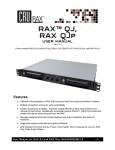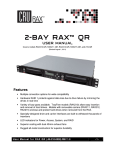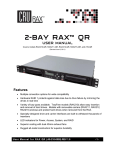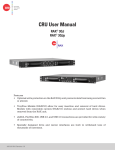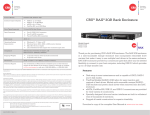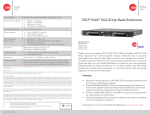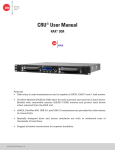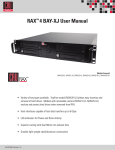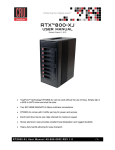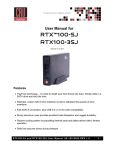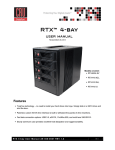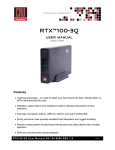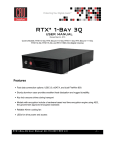Download CRU RAX212-SJ
Transcript
2-BAY RAX™ USER MANUAL (Revised November 9, 2011) Covers models RAX210-NJ, RAX210-SJ, RAX210-SV, RAX 210-XJ, RAX211-SV, RAX211-XJ, RAX212-SV, RAX212-SJ, RAX219-NJ, RAX219-SJ, RAX219-SV, RAX219-XJ Features • Variety of bay types available. TrayFree models (RAX210) allow easy insertion and removal of hard drives. Models with removable carriers (RAX211, RAX212) enclose and protect hard drives when removed from the RAX. • Specially-designed drive and carrier interfaces are built to withstand thousands of insertions • LED indicators for Power and Drive Activity • Superior cooling with dual 40mm exhaust fans • Sturdy metal case provides excellent heat dissipation and rugged durability U s e r M a n u a l f o r 2 - B a y R AX ( A9-210-0008) REV 1.0 -1- CRU Table of Contents 1. Pre-Installation Steps 3 1.1 Box Contents 3 1.2 Identifying Parts 3 2. Installation Steps 4 2.1 Installing Hard Drives 4 2.1.1 HDD Installation for RAX210 4 2.1.2 HDD Installation for RAX211 and RAX212 4 2.1.3 Drive, bay, and frame installation for RAX219 and models with one open bay 4 2.2 Tips for Rack Mounting 4 2.3 RAX Host Connections 5 2.4 Connecting and powering RAX 5 3. Encryption (RAX212 only) 5 4. Usage with Mac and Windows Operating Systems 5 4.1 Usage with Macintosh Computers 5 4.1.1 Compatibility 5 4.1.2 Formatting a drive 5 4.1.3 Mounting and Ejecting Volumes 6 4.1.4 Creating a boot drive 6 4.2 Usage with Windows Operating System 6 4.2.1 Compatibility 6 4.2.2 Formatting a drive 6 4.2.3 Mounting and Ejecting Volumes 7 4.2.4 Creating a boot drive 8 5. Frequently Asked Questions 8 6. Technical Specifications 9 U s e r M a n u a l f o r 2 - B a y R AX ( A9-210-0008) REV 1.0 -2- CRU 1. Pre-Installation Steps 1.1 Box Contents Check the accessories with your RAX unit. Please contact CRU if any parts are missing or damaged. The box should contain the following items: Accessories RAX unit Quantity 1 Power cord Key set Screw kit Quick Start Guide and warranty information 1 1 1 1 1.2 Identifying Parts Take a moment to familiarize yourself with the parts of the 2-bay RAX unit. This will help you to better understand the remaining instructions. Front View Power Switch (on/off) Mounting Bracket Ejection Handle Bay Access LED Key Lock Power LED Fan Status LEDs Bay Power LED Rear View 4cm Exhaust Fan AC Power Inlet Multi-lane SAS/SATA port* *Host connection for “NJ” model shown here. For information on host connections of other RAX models, see section 2.3. U s e r M a n u a l f o r 2 - B a y R AX ( A9-210-0008) REV 1.0 -3- CRU 2. Installation Steps 2.1 Installing Hard Drives 2.1.1 HDD Installation for RAX210 a) Pull on the ejection handle and open the door. b) Slide in your SATA hard drive, connector-end first. Note: the drive’s label should be facing up. c) Shut the door. 2.1.2 HDD Installation for RAX211 and RAX 212 a) Slide the drive carrier out of the RAX. b) The carrier’s cover is held in place by a screw on the rear of the carrier. Remove the screw, then remove the cover. c) Slide the drive in from the front of the carrier. d) Mate the connection on the drive with the connection on the drive carrier circuit board. e) Flip the drive/carrier assembly over, and secure the drive in place with the provided screws. f) Attach the Temperature Control Cooling Sensor to the top of the drive with an adhesive strip. g) Replace the carrier cover and secure the screw on the rear of the carrier. h) Slide the carrier into the RAX. i) NOTE – A flashing green LED on the bay indicates bay fan failure. Call CRU technical support for assistance. 2.1.3 Drive, bay, and frame installation for RAX219 and models with one open bay. 2-Bay RAX models can be purchased with one or both bays unpopulated. RAX219 is the “empty bay” model of the 2-bay RAX series. For instructions on how to install your HDD, bay, or frame into these products, please see the install guide that accompanies your particular bay. 2.2 Tips for Rack Mounting • Elevated Operating Ambient: If installed in a closed or multi-unit rack assembly, the operating ambient temperature of the rack environment may be greater than room ambient. • Reduced Air Flow: Installation of the equipment in a rack should be such that the amount of air flow required for safe operation of the equipment is not compromised. • Mechanical Loading: Mounting of the equipment in the rack should be such that a hazardous condition is not achieved due to uneven mechanical loading. • Circuit Overloading: Consideration should be given to the connection of the equipment to the supply circuit and the effect that overloading the circuits might have on over current protection and supply wiring. Appropriate consideration of equipment nameplate ratings should be used when addressing this concern. • Reliable Earthing: Reliable earthing of rack-mounted equipment should be maintained. Particular attention should be given to supply connections other than direct connections to the branch circuit (e.g. use of power strips). U s e r M a n u a l f o r 2 - B a y R AX ( A9-210-0008) REV 1.0 -4- CRU 2.3 RAX Host Connections Connection FireWire 800 QR Model 2 QJ Model 4 QJp Model 4 1 1 2 2 2 2 USB 2.0 eSATA Port-Multiplied eSATA Multi-Lane SAS/SATA 3Gps (SFF-8470) Multi-Lane SAS/SATA 6Gbps (SFF-8088) SJ Model SV Model NJ Model XJ Model 2 1 1 1 2.4 Connecting and Powering RAX Connect the data cables to RAX and your computer. Plug in the power cord to a grounded electrical outlet. With hard drives in the unit, turn on the power. • • For the RAX210, the drives will begin to spin up automatically. For the RAX211 and 212, use the included set of keys to turn the key lock 90 degrees clockwise to power on each hard drive. Your RAX is now ready to use! If the hard drives are already formatted, RAX can be used right away. If the hard drives are brand new, or the formats are not compatible with your computer, the drives will need to be formatted before being used. See section 4, “Usage with Mac and Windows Operating Systems” for information on formatting. 3. Encryption information (RAX212 models only) RAX212 includes an internal encryption key preinstalled in each bay. After inserting any drive and formatting it, that drive will only be readable in the RAX212 and will be fully encrypted—including the boot sector, operating system and all files—without performance degradation. The internal key can be overridden by inserting a different key in the front of the bay. 4. Usage with Mac and Windows Operating Systems 4.1 Usage with Mac OS X 4.1.1 Compatibility RAX uses 3.5-inch SATA (Serial-ATA) hard drives only. RAX does not require drivers for operation under Mac OS X. However, if you install a host card specifically to work with this product, that card may require drivers. See your card’s User Manual for drivers and instructions. 4.1.2 Formatting a drive If you purchased your RAX pre-populated with hard drives, this step should not be necessary unless you wish to change the format or erase the drive. To format, use Mac OS X’s Disk Utility (found in the applications folder). U s e r M a n u a l f o r 2 - B a y R AX ( A9-210-0008) REV 1.0 -5- CRU a) Click on the drive in the window to the left (see picture below). b) Click the Erase tab in the window to the right (see picture below). c) Select the format type. Most users prefer Mac OS Extended with Journaling (HFS+), which is required for compatibility with Time Machine (OS 10.5 or newer). If you need to use your RAX with both Mac and Windows computers, select MS-DOS File System instead. d) Enter a name for the new volume and then click “Erase” to start the process. 4.1.3 Mounting and unmounting volumes If the hard drives installed in RAX are already formatted, an icon representing the drive’s volume will appear (mount) on the desktop. You can begin using the volume right away. If the drive is unformatted, a message will appear on the desktop saying that the disk is unreadable. You can use OS X’s Disk Utility to easily format the drive (see section above). Unmount the volume before powering down the unit by dragging the volume’s icon to the trash bin, or by selecting the volume then pressing Command-E. Disconnecting the unit without first unmounting the volume can result in data loss. 4.1.4 Creating a Boot Drive To activate this feature, you must first install OS X on the hard drive in your carrier. The easiest way to do this is to clone an existing system drive using a utility such as Carbon Copy Cloner or Super Duper. Next, go to System Preferences Startup Disk. A window will list the available bootable volumes. Select the volume from which you wish to boot. Another method is to hold down the Option key during boot up. A screen should appear that allows you to select the volume you wish to use. This is useful if you wish to boot from your RAX hard drive only some of the time. 4.2 Usage with Windows operating systems 4.2.1 Compatibility RAX uses 3.5-inch SATA (Serial-ATA) hard drives only. RAX does not require drivers for operation under Windows XP, Vista, or 7. However, if you install a host card specifically to work with this product, that card may require drivers. See your card’s User Manual for drivers and instructions. 4.2.2 Formatting a drive If you purchased your RAX pre-populated with a hard drive, this step should not be necessary unless you wish to change the format or erase the drive. To format, use the Disk Management utility. U s e r M a n u a l f o r 2 - B a y R AX ( A9-210-0008) REV 1.0 -6- CRU a) Right-click on My Computer, then select Manage. The Computer Management window will open. b) In the left pane of this window, left-click on Disk Management. c) The drive should appear in the list of Disks in the lower middle/right pane (see picture below). You may need to scroll down to see it. If the drive is already formatted, you can identify it easily by its volume name. If it’s unformatted, the Drive Properties Box will say “Unallocated” and you’ll need to initialize the disk before formatting it. Initialize the disk by right-clicking the Device Properties Box and selecting Initialize Disk. Device Properties Box Drive Properties Box d) To format the drive, right-click the Drive Properties Box and select Format. e) If you are prompted to select a partition type, select MBR for volumes 2TB or smaller, or GPT for volumes larger than 2TB. Note: Windows XP does not support GPT or volumes larger than 2TB. f) Click through several more windows, leaving the default settings, until you see a window that allows selection of a file system. Choose NTFS and enter a name for the new volume. Be sure to check the box labeled “Perform a quick format” unless you want to completely erase any data on the drive and have time to wait. A quick format should take less than a minute, while standard formatting may take several hours. g) Click “Next” and then “Finish” to start the format process. When the format is complete, the Drive Properties Box will update to show the new volume name. The new volume can now be found in My Computer. 4.2.3 Mounting and ejecting volumes If the hard drives attached to RAX are already formatted, you can begin using the volume right away. When the unit is properly connected and turned on, a window may open to allow you access to the volume. If no window appears, you can find the volume by double-clicking “My Computer.” Eject the RAX before powering it down by single-clicking the green arrow icon on the task bar, then selecting “Safely remove….” Windows will indicate when it is safe to disconnect RAX. Disconnecting the unit without first ejecting it can result in data loss. U s e r M a n u a l f o r 2 - B a y R AX ( A9-210-0008) REV 1.0 -7- CRU 4.2.4 Creating a Boot Drive Some PC motherboards support booting from an external device. To activate this feature, you will need to adjust the motherboard’s BIOS settings. Check with your motherboard’s manufacturer or owner’s manual for details. 5. Frequently Asked Questions (FAQ) Q: Why won’t the computer let me eject or unmount my drive? A: There may be a software application running in the background with an active link to the drive. Sometimes, you may see a message such as “The disk is in use and could not be ejected. Try quitting applications and try again.” Try invoking the Force Quit feature in OS X to see what software may be running. For Windows, the equivalent command is CTRL-ALT-DEL. Drives connected to the computer via eSATA cannot be ejected in Windows the way FireWire or USB drives can. However, freeware utilities are available on the internet that provide a similar function. Q: What kind of host bus adapter (HBA) will I need for this product? A: Most SATA or SAS HBAs will work with RAX as long as there is a converter cable that will convert RAX’s host connection to the connection type on the HBA. For instance, converter cables can often be found that convert multi-lane SAS/SATA (SFF-8470) to a “mini-SAS” (SFF-8088) connector or four separate SATA or eSATA connectors. Some of these converters are available at www.wiebetech.com or www.cru-dataport.com. Q: Does my 2-bay RAX unit support RAID? A: The models covered in this manual support only JBOD functionality. However, the drives can be RAIDed in software, or RAX can be attached to a RAID HBA for hardware RAID functionality. Q: Will this product work with hard drives larger than 2.2TB? A: Yes, assuming the rest of your configuration (e.g. OS, BIOS, host drivers) supports large volumes, this product is compatible with drives larger than 2.2TB. Q: Why is my hard drive experiencing data corruption? A: Many things can cause data corruption on hard drives, whether they are inside your computer or inside an external storage product. Malicious software, OS bugs, failure to properly disconnect external devices, or no reason at all. Data corruption or loss is therefore not covered by warranty (this is the case with all rational companies in the storage industry). The first thing to try is restarting both the computer and the external device. If the data is still corrupted, try running built-in OS utilities (such as Mac OS X's Disk Utility First Aid) on the hard drive. For best results, boot your computer with a Mac OS X Installation CD, and launch Disk Utility from the CD. When you reach the Mac OS Installation program, you can run Disk Utility from one of the menus at the top of the screen. From Disk Utility, you can run "Verify Disk" and "Repair Disk" to find and fix any errors that may be present in your Mac OS installation. If the OS utility doesn't help, you may need Data Rescue. This is a great solution for recovering lost data from a hard drive which has suffered data loss or corruption. If there is a true hardware failure of your hard drive that prevents it from communicating with your computer, there is no software solution in existence that can fix this problem. However, since we cannot tell you with any certainty whether or not you are experiencing hardware failure in your particular hard drive, we would encourage you to download a free demo version of ProSoft’s Data Rescue from www.prosofteng.com. It is limited, in that it only allows you to recover one file per session, but it will tell you if it even sees any files. For more FAQs and additional information, please visit www.cru-dataport.com. U s e r M a n u a l f o r 2 - B a y R AX ( A9-210-0008) REV 1.0 -8- CRU 6. Technical Specifications Drive Types Supported: • RAX “SJ” models: dual eSATA • RAX “SV” models: single port-multiplied eSATA • RAX “NJ” models: SFF-8470 multi-lane SAS/SATA 3Gbps • RAX “XJ” models: SFF-8088 multi-lane SAS/SATA 6Gbps 3.5-inch SATA (Serial-ATA) hard drives Power LED: Yes, one for each drive Access LED: Yes, one for each drive • Windows XP, Vista, Windows 7 • Mac OS X • Linux distributions that support the connection type (RAX212 models only) Full disk hardware encryption, AES 128 or 256 Input: 100-240VAC Output: 220 Watts Dual 40mm exhaust fans EMI Standard: FCC Part 15 Class A, CE EMC Standard: EN55022, EN55024 15 pounds 17 pounds without drives 23 pounds with drives 429mm W x 413mm D x 44mm H We don’t want anything to go wrong with your CRU-Dataport product. But if it does, Technical Support is standing by and ready to help. Contact Technical Support through cru-dataport.com/support or call (800) 260-9800. Host Interfaces: Operating System Requirements: Encryption: Power Supply: Cooling Fan: Compliance: RAX Weight: Shipping Weights: Dimensions: Support: RAX and TrayFree are trademarks of CRU Acquisitions Group, LLC. Other marks are the property of their respective owners. © 2010 CRU Acquisitions Group, LLC. All rights reserved. Limited Product Warranty CRU-DataPort (CRU) warrants RAX to be free of significant defects in material and workmanship for a period of two years from the original date of purchase. CRU’s warranty is nontransferable and is limited to the original purchaser. Limitation of Liability The warranties set forth in this agreement replace all other warranties. CRU expressly disclaims all other warranties, including but not limited to, the implied warranties of merchantability and fitness for a particular purpose and non-infringement of third-party rights with respect to the documentation and hardware. No CRU dealer, agent or employee is authorized to make any modification, extension, or addition to this warranty. In no event will CRU or its suppliers be liable for any costs of procurement of substitute products or services, lost profits, loss of information or data, computer malfunction, or any other special, indirect, consequential, or incidental damages arising in any way out of the sale of, use of, or inability to use any CRU product or service, even if CRU has been advised of the possibility of such damages. In no case shall CRU’s liability exceed the actual money paid for the products at issue. CRU reserves the right to make modifications and additions to this product without notice or taking on additional liability. FCC Compliance Statement: “This device complies with Part 15 of the FCC rules. Operation is subject to the following two conditions: (1) This device may not cause harmful interference, and (2) this device must accept any interference received, including interference that may cause undesired operation.” This equipment has been tested and found to comply with the limits for a Class A digital device, pursuant to Part 15 of the FCC Rules. These limits are designed to provide reasonable protection against harmful interference when the equipment is operated in a commercial environment. This equipment generates, uses, and can radiate radio frequency energy and, if not installed and used in accordance with the instruction manual, may cause harmful interference to radio communications. Operation of this equipment in a residential area is likely to cause harmful interference in which case the user will be required to correct the interference at this own expense. In the event that you experience Radio Frequency Interference, you should take the following steps to resolve the problem: 1) Ensure that the case of your attached drive is grounded. Tested to comply 2) Use a data cable with RFI reducing ferrites on each end. with FCC standards 3) Use a power supply with an RFI reducing ferrite approximately 5 inches from the DC plug. FOR OFFICE OR COMMERCIAL USE 4) Reorient or relocate the receiving antenna U s e r M a n u a l f o r 2 - B a y R AX ( A9-210-0008) REV 1.0 -9-









